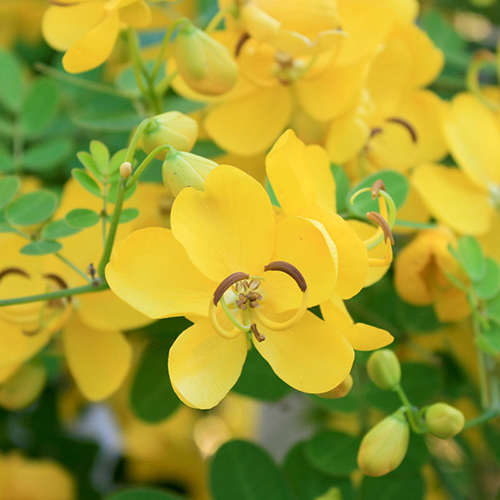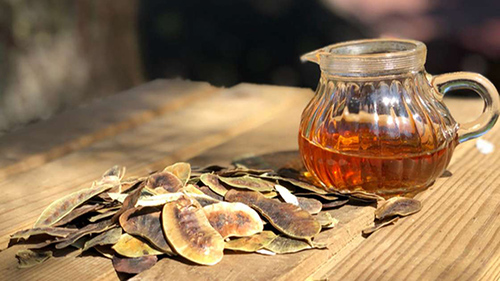Contents
Cassia angustifolia, introduced to Europe by the Arabs in the 11th century, was one of the most appreciated purgative plants. With it, lunatics were drastically purged, with results less successful than expected. In this way, with energetic diarrhea and bleeding, ancient physicians exercised their art. Today, cassia angustifolia is one of the most commonly used medicinal herbs as an effective and safe laxative.

Cassia Angustifolia Scientific Facts
- Other names: Tinnevelly senna, Indian senna.
- French: Sene.
- Spanish: Sen.
- Environment: Native to Arabia, Somalia, and other countries on the Red Sea coastline. Widely cultivated in southern India.
- Description: This shrub of the Leguminosae family grows from 0.5 to 1 m high. Its leaves have five to eight pairs of oval folioles. The flowers are yellow, and the fruit is a plain-shaped legume containing six to eight seeds.
- Parts of the plant used medicinally: The folioles (leaves) and the seeds.
Healing Properties and Warning
The LEAVES and SEEDS of cassia angustifolia contain 2-3 percent of anthraquinone glycosides, known as sennoside A and B; they also contain mucilage and flavonoids, which help in the plant’s laxative properties, and a resin with irritant action which, when taken in large doses, can provoke vomiting and nausea.
Sennosides are inactive in their natural condition. They pass through the stomach without alteration, then partially absorbed in the small intestine and eliminated with the bile. When arriving in the colon, sennosides are chemically transformed by some enzymes produced by intestinal bacteria (glycosides), which liberate the genine (aglycon), the active component of the sennoside molecules.
The chemical reaction produced is sennoside (glycoside) + enzyme = genin (active component) + sugar. Active derivatives of sennosides exert their laxative action through two mechanisms.
- By stimulating the action of the large intestine, increasing peristaltic movements. Though with lesser intensity, they also increase the muscular tone of the urinary system and the uterus.
- It decreases the permeability of the intestinal mucosa, making the normal absorption of water in the large intestine more difficult.
Depending on the dose, cassia angustifolia produces two effects:

- Laxative. It eases the emission of soft feces with no colic.
- Purgative: It causes evacuation of liquid, diarrheic feces, accompanied by cramps (colic).
The purgative or laxative effects manifest themselves six or seven hours after taking the plant. These effects may last one or two days and are never followed by reactive constipation.
The use of cassia angustifolia is recommended for constipation caused by traveling, diet changes, childbirth, and after surgical operations. It is beneficial to prevent straining during defecation in patients suffering from high blood pressure or angina pectoris.
WARNING! Due to its stimulant effect on the hollow abdominal organs, which are covered by smooth muscle fibers (especially the uterus and the bladder), it must not be used during pregnancy or menstruation, and it must not be used for colitis or cystitis.
In the case of anal and rectal afflictions (fissures, hemorrhoids, etc.), it must be used with care and always in low doses.
This herb is one of the most reliable laxatives that increases intestinal peristaltic movements. For even better results, combine it with other carminative herbs, such as coriander, fennel, anise, and ginger, to avoid bowel cramps. Adults should use six to twelve pods and three to six pods for children. The pods are more desired because they’re milder than the leaves. Prepare an infusion of one ounce of cassia Angustifolia to one pint of water, then add ten percent of an aromatic herb. Steep for twenty minutes and drink it cold.
Do not prepare more than you can immediately consume (about ½ to one cup at a time). Cassia Angustifolia can also be combined with other anthelmintics to expel parasitic intestinal worms. Externally, this herb is helpful as a mouthwash for bad taste in the mouth and halitosis.
How to use Cassia Angustofolia

- Infusion. Ground cassia angustifolia lobules powder is used in doses ranging from 1 to 8 g in infusion at night. Two or three grams are usually enough to achieve a laxative effect. Children have enough with half this dose. It should not be taken more than seven consecutive days.
To avoid the irritant effects of its resin, which, in large doses, can provoke nausea and vomiting, we recommend soaking cassia angustofolia leaves in alcoholic cold extract for 24-48 hours. After this time, discard the alcohol and prepare an infusion with the leaves. - Cassia angustifolia extract. Recently, pharmaceutical industries have introduced to the market dried sennosides, which are presented in the form of different pharmaceutical preparations. These substances lack any of the resin’s irritant effects, thus being especially appropriate for children and older people.
- Enema. Prepare an infusion of 20-30 g of tinnevelly senna per liter of water, which will be administered as an enema. The effects are immediate.
Other Cassia Species
Besides cassia angustofolia, which is the most commonly used species, there are other species with similar properties: so-called Alexandria senna (Cassia senna L. = Cassia acutifolia Del.), Spanish senna (Cassia obovate Colladon), and American senna (Cassia marylandica L.). The properties and applications of all species are similar, though they differ from those of Indian senna in that they present a lower concentration of active components.
DISCLAIMER: All content on this website is presented solely for educational and informational objectives. Do not rely on the information provided as a replacement for advice, diagnosis, or treatment from a qualified medical expert. If you are pregnant, nursing, or have any preexisting medical concerns, talk to your doctor before using any herbal or natural medicines.
REFERENCES
- George D. Pamplona-Roger, M.D. “Encyclopedia of Medicinal Plants.” George D. Pamplona-Roger, M.D. Encyclopedia of Medicinal Plants. Ed. Francesc X. Gelabert. vols. 2 San Fernando de Henares: Editorial Safeliz, 2000. 492, 493. Print. [Cassia angustifolia]
- Vance Ferrell Harold M. Cherne, M.D. The Natural Remedies Encyclopedia [Book]. – Altamont, TN: Harvestime Books, 2010. – Vol. Seventh Edition: 7: pp. 179.
- Reputable Health Organizations: https://gastro.org/
- Cleveland Clinic: https://my.clevelandclinic.org/
